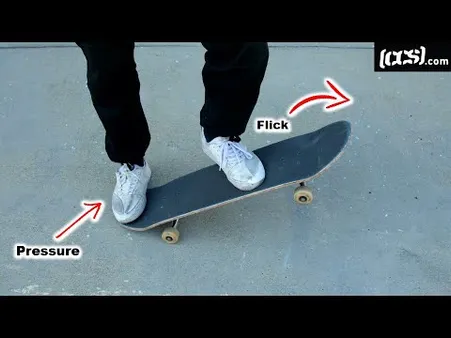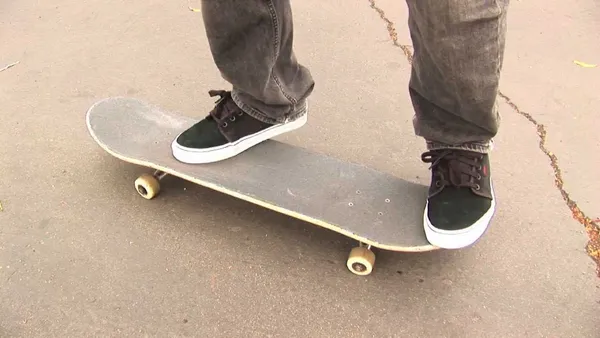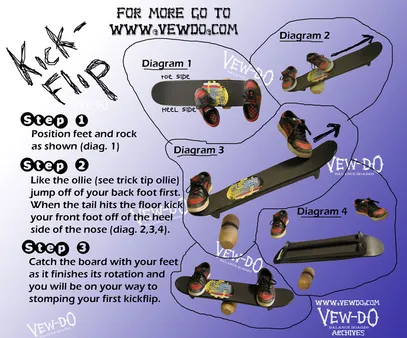Table of Contents
If you're eager to learn How to do a kickflip, Kizworld has crafted this comprehensive guide to help you conquer this skateboarding trick. With step-by-step instructions, equipment recommendations, troubleshooting tips, and progression strategies, kizworld's guide will guide you from novice to kickflip master. Get ready to elevate your skateboarding skills and experience the thrill of landing kickflips consistently.
How to Do a Kickflip: Unlock the Art of Skateboarding Freestyle
I. Preparation for a Kickflip
Preparation for a Kickflip
Choosing the Right Skateboard
The first step in learning how to do a kickflip is choosing the right skateboard. Look for a skateboard that is the right size for your body and skill level. If you are a beginner, you should choose a skateboard that is shorter and narrower than a skateboard meant for an experienced skater. You should also choose a skateboard with a slightly concave deck to help you with your balance. Once you have chosen a skateboard, you need to make sure it is properly set up. This includes adjusting the trucks and wheels to your liking.
Brand | Price | Features |
Powell Peralta | $100 - $200 | High-quality materials and construction, durable, good for all skill levels |
Element Skateboards | $80 - $150 | Affordable, good for beginners, wide range of designs |
Plan B Skateboards | $120 - $250 | High-performance, good for experienced skaters, innovative designs |
Safety Gear
Before you start practicing your kickflip, it is important to wear safety gear. This includes a helmet, knee pads, elbow pads, and wrist guards. Helmets are essential for protecting your head in case of a fall, and knee pads, elbow pads, and wrist guards can help protect you from scrapes and bruises.
- Helmet: A helmet is the most important piece of safety gear. It can protect your head from serious injury in case of a fall.
- Knee pads: Knee pads can protect your knees from scrapes and bruises when you fall. They are especially important for beginners who are learning to do tricks.
- Elbow pads: Elbow pads can protect your elbows from scrapes and bruises when you fall. They are also helpful for preventing elbow pain from repeated use.
- Wrist guards: Wrist guards can protect your wrists from sprains and breaks when you fall. They are especially important for beginners who are learning to do tricks.
Practice Area
Once you have your skateboard and safety gear, you need to find a safe place to practice your kickflip. The best place to practice is a smooth, flat surface away from traffic and other obstacles. You can also practice in a skatepark, but be sure to follow the rules and regulations of the park.
"The best way to learn how to do a kickflip is to practice regularly. The more you practice, the better you will become."- Tony Hawk
II. Performing a Kickflip
Performing a Kickflip
Grasp the board from its lower center ,appropriately 2 to 4 inches or 5 to 10 centimeters. Make sure your skateboard is sitting with the front end facing straight ahead and the nose of the board tilted slightly up.
Pop and Flick
Utilizing the rear foot, position it straightly over the tail. Use your rear foot’s heel to fiercely press down on the skateboard’s tail. Then quickly pull your rear foot towards your body as you jump up. This movement, called the pop, propels the board into the air, pivots it, and arranges it for the foot's landing. At the exact moment you do that action, jump up with both feet and lift your knees to your chest. Simultaneously, spring up directly upwards. Quickly, as the board goes up, extend your front foot forward and, while it's doing that, move it in an upward and outward motion. You should slide your front foot forward alongside the board, your toes. If you execute these actions simultaneously, the board will finish its spin, landing under your feet.
TIP: When you initial practice kickflips, practice popping and flipping the board without jumping. Practice this motion many times with both feet still on the board. This way you’ll learn to do the kickflip motion without worrying about jumping. |
|---|
Landing and Rolling Away
spread your feet shoulder-width apart, bend your knees, and let your weight sink as you gradually cradle the board back to the ground. Lower the board below you and be ready for it to land. Keep your legs bowed as you land to absorb the impact, rolling away from the landing spot as your feet touch the ground.
Troubleshooting
- Problem: The board doesn’t flip.
- Solution: Make sure you are flicking the board hard and fast, and follow through with your motion.
- Problem: The board flip excessively.
- Solution: Ensure you follow through with your flicking motion. Do not release your front foot before it reaches the edge of the board.
- Problem:: The board lands far away from you.
- Solution: Practice popping and flicking the board more quickly for it to land closer.
III. Troubleshooting Common Issues
Troubleshooting Common Issues
- Kickflip not leveling out: Incorrect weight distribution, poor foot positioning, or inadequate flick.
- Board not rotating fully: Insufficient commitment, weak flick, or lack of body rotation.
- Landing with the wrong foot on top: Mistiming the kickflip or not keeping the eyes on the board.
- Board flipping over: Too much toe pressure on the front foot or too little flick.
To address these issues, remain patient, practice consistently, and focus on refining technique. Start with stationary kickflips and progress to moving kickflips. Analyze video footage of your attempts to identify areas for improvement. Seek guidance from experienced skateboarders or join a skatepark community for support and feedback.
| Causes & Solutions |
Ollie before Kickflip | Mastering ollies builds a solid foundation for kickflips. Practice ollies regularly to improve your pop and control. |
Start Small | Begin with stationary kickflips and gradually incorporate movement. This helps develop muscle memory and confidence. |
Proper Footwear | Choose skateboarding shoes with flat soles and good grip. This ensures optimal board control and prevents slipping. |
Skatepark Etiquette | Respect fellow skaters, follow safety guidelines, and avoid crowding obstacles. Create a positive and supportive environment. |
Skateboarding is an exhilarating sport that requires dedication and perseverance. Embrace the learning process and relish the sense of accomplishment as you conquer new tricks. Stay committed, seek guidance when needed, and enjoy the thrill of riding.
IV. Tips for Mastering the Kickflip
Tips for Mastering the Kickflip
Consistently Land Your Kickflips
Practice regularly to develop muscle memory and coordination for landing kickflips consistently. As you practice, focus on keeping your weight centered over the board, your body relaxed, and your eyes fixed on the landing spot.
- Use a comfortable stance: Adjust your foot position on the board to find a stance that allows you to easily shift your weight and control the board.
- Practice on flat ground: Start by practicing kickflips on flat ground to build confidence and get a feel for the movement before attempting them on obstacles or ramps.
- Focus on your timing: The key to landing kickflips consistently is timing the pop, flick, and landing correctly.Learn how to do a backflip
Perform the Kickflip with Proper Technique
Pay attention to details such as the angle of your foot, the speed of your flick, and the position of your body to execute the kickflip smoothly and effectively.
Aspect | Tip |
Foot Angle | Keep your front foot slightly angled outward for better control and stability. |
Flick Speed | Flick your front foot with a quick, sharp motion to generate the necessary rotation. |
Body Position | Keep your body centered over the board and slightly crouched to maintain balance during the flip. |
Overcome Common Mistakes
Identify and correct common errors that may hinder your progress in landing kickflips successfully. Some typical mistakes include:
- Popping the board too early or too late: Adjust the timing of your pop to ensure the board rotates fully under your feet.
- Flicking your foot too hard or too softly: Experiment with the力度of your flick to find the right amount of force to rotate the board.
- Not committing to the landing: Commit to landing the kickflip by keeping your weight centered and eyes focused on the landing spot.Learn how to do a roundoff
Additional Tips for Mastering the Kickflip
In addition to the techniques and practice mentioned above, consider these extra tips for improving your kickflip skills:
- Warm up your muscles: Perform dynamic stretches and light exercise before attempting kickflips to prevent injuries and improve your range of motion.
- Wear protective gear: Use a helmet, knee pads, and elbow pads to protect yourself from potential falls and injuries while practicing.
- Seek guidance from experienced skateboarders: If you have the opportunity, seek guidance from experienced skateboarders who can provide valuable tips and feedback on your technique.
- Stay patient and persistent: Mastering the kickflip takes time and dedication. Keep practicing consistently and don't get discouraged by initial setbacks.
Variations to Expand Your Kickflip Skills
Once you have mastered the basic kickflip, you can explore variations to add style and difficulty to your skateboarding tricks. Some popular variations include:
- Varied kickflips: Experiment with different variations such as frontside 180 kickflips, backside 180 kickflips, and kickflips with grabs to add variety to your repertoire.
- Double kickflips: Perform two consecutive kickflips in quick succession for an impressive display of skill and control.Learn how to do a walkover
- Kickflips on obstacles: Take your kickflips to the next level by performing them on obstacles like stairs, benches, or rails to demonstrate your skateboarding prowess.
V. Conclusion
With persistent practice, the kickflip can transform from a daunting trick into a staple move in your skateboarding arsenal. By following the step-by-step guide, familiarizing yourself with common mistakes, and incorporating the helpful tips provided, you'll progress steadily towards executing kickflips with confidence and style. Remember, the journey of mastering skateboarding tricks is all about dedication, perseverance, and finding joy in the process of learning. So, keep pushing your limits, stay patient, and relish the thrill of landing that perfect kickflip.